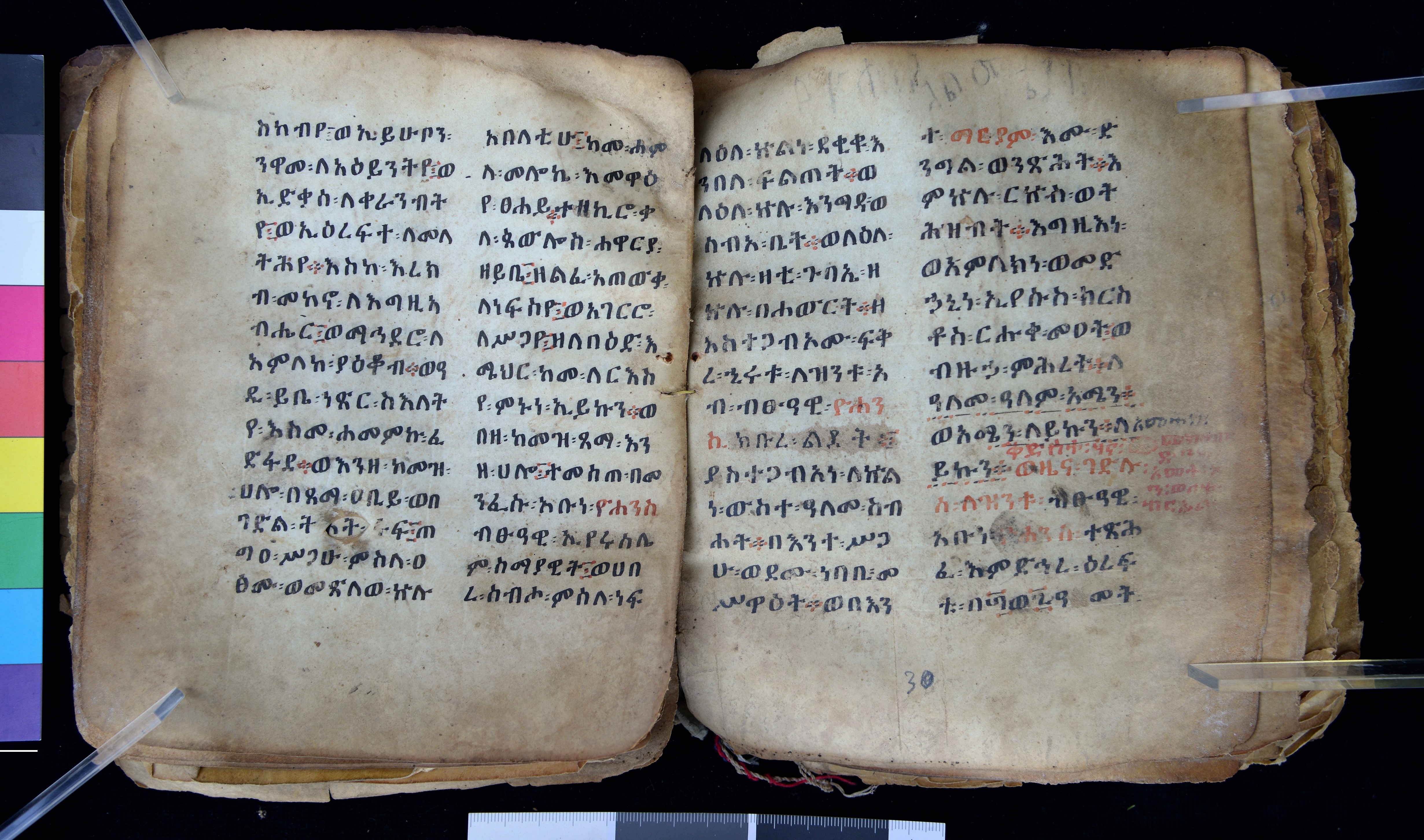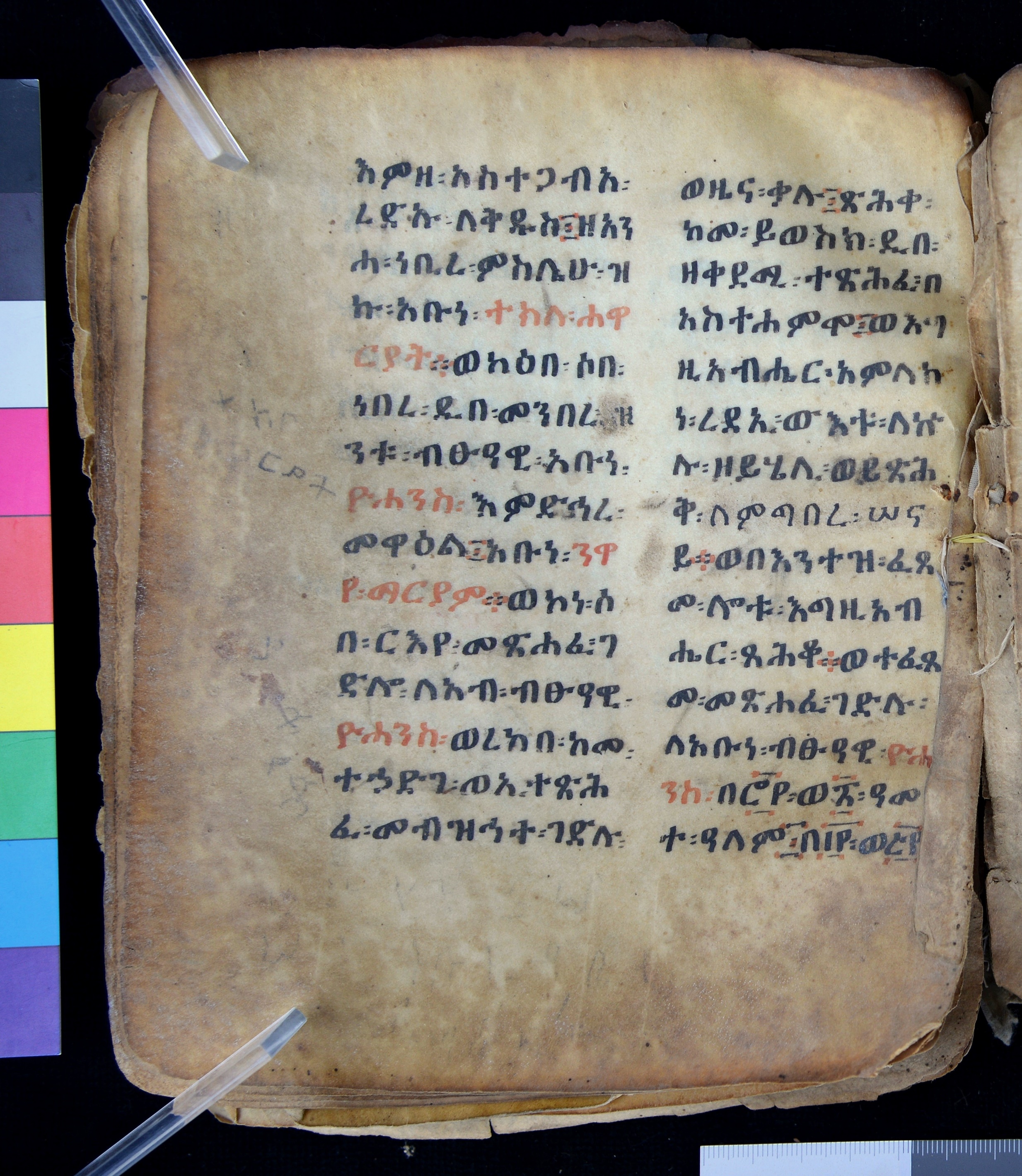New data on the hagiographic tradition of Yoḥannes of Wifāt
(D. Nosnitsin, 8 January 2024)
In the course of the latest field research (November 2023, see also https://www.betamasaheft.uni-hamburg.de/about/situation/fieldwork.html) it was possible to collect more data on one of the lesser known hagiographic traditions of Ethiopia, that of Yoḥannes of Wifāt. This saint appears in the well-known register of saints and hagiographic works published by Kinefe-Rigb Zelleke in 1975, but there he is merged with Yoḥannəs Məśrāqāwi (“Oriental”).1 Later Yoḥannəs of Wifāt received a separate entry in Enciclopedia dei santi: le chiese orientali, and its author Osvaldo Raineri concluded that Yoḥannəs of Wifāt was a monastic leader who died in 1443/44.2 The founder of the monastery of (Dabra) Wifāt, he was a monk from the southern or central Ethiopia. As a a few other monasteries, Dabra Wifāt might have been prominent up to the 16th century, but disappeared due to the 16th-century Muslim wars and population movement. However, the veneration of Yoḥannəs of Wifāt continued in northern Ethiopia, similar to the cases of some other saints, such as for instance Takla Hāymānot and Gabra Manfas Qəddus.
The first literary witness of the tradition was discovered during a field mission of the project Ethio-SpaRe as early as 2012, in the library of the monastery Rubākusa Giyorgis in Tamben. The finely written 18th-century manuscript Ethio-SPaRe RQG-0073 contains a series of hagiographic works, such as: 1) Acts of Yoḥannəs of Wifāt (fols 2r-75r, see also fig 22a and fig 22b from the mission report ), 2) Miracles of Yoḥannəs of Wifāt (fols 76v-89r); 3) Acts of Mātewos (90r-140r); 4) Miracles of Mātewos (fols 147r-171v), and a few other texts.4 The commemoration day of Yoḥannəs is said in his Acts to be 7 Gənbot. As to Mātewos, his close associate, his Acts mention 21 Maskaram as his commemoration day. Mātewos is not mentioned in Kinefe-Rigb Zelleke’s register. The works feature colophons with detailed chronological information.
Some recent finds helped to better contextualise MS Ethio-SPaRe RQG-007 and its content. I have detected another interesting manuscript of the Acts and Miracles of Yoḥannəs and Mātewos as early as 2018 in a small church Qanaf Gabriʾel located in waradā ʾĀdet (Central Tigray). But I was able to photograph the Acts in full only in November 2023.5 The manuscript is in poor condition. The volume has the size approximately 230 x 200 x 40mm; no proper binding has been preserved. The leaves are in disorder, and kept together by a rectangular piece of leather, with remains of a few other manuscripts included. Some 75 leaves of the Acts and Miracles of Yoḥannəs and Mātewos have survived, representing hopefully the biggest part of the original manuscript. The handwriting is suggestive of the first half of the 16th century as the manuscript production time (fig. 1). Hagiographic manuscripts with the Acts of the local saints dating to that or earlier time are quite rare. Only a part of the colophon of the manuscript from Qanaf has survived, it runs exactly as in MS RQG-007 and contains the date of the composition of the Acts of Yoḥannəs, the year 7020 from the creation of the world (fig. 2) which corresponds to 1528 CE. In fact, this date matches the estimated production time of the manuscript found at Qanaf.6
In addition, Mr Amanuel Abrha (Adigrat University) kindly informed me in December 2023 about a church called ʾƎndā Yoḥannəs in waradā Ḥāḥāyle7 which is dedicated to Yoḥannəs of Wifāt. It possesses at least one recent manuscript of his Acts. A few more churches related or dedicated to Yoḥannəs of Wifāt are reported to exist, being traces of the old veneration tradition.
It is not the first time that the field research has pushed further the limits of our knowledge of Ethiopic literature and Ethiopian cultural patrimony, and yields more interesting Ethiopic works to study.
Fig. 1: MS Qanaf Gabriʾel, Acts of and Miracles of Yoḥannəs of Wifāt and Mātewos, first half of the 16th century, fols 29v-30r
Fig. 2: MS Qanaf Gabriʾel, Acts of and Miracles of Yoḥannəs of Wifāt and Mātewos, first half of the 16th century, fol. 30v
Footnotes
1 See Kinefe-Rigb Zelleke, “Bibliography of the Ethiopic Hagiographical Traditions”, Journal of Ethiopian Studies 13, 2, 1975, 57-102, here 98-99, no. 182.
2 See Osvaldo Raineri, “Giovanni di Wifāt”, in J.N. Cañellas – S. Virgulin – G. Guaita (eds.), Biblioteca sanctorum orientalium. Enciclopedia dei Santi. Le Chiese Orientali, vol. I (A - Gio), Roma: Città Nuova 1998, 1198.
3 The outer size 280 x 242 x 83mm; bound on two boards with traditional leather covering; fine textile inlays; sewn on two pairs of sewing stations. Preliminary description was completed by Magdalena Krzyzanowska (12.11.2012).
4 Mentioned and briefly discussed in Denis Nosnitsin, Churches and Monasteries of Tǝgray. A Survey of Manuscript Collections, Wiesbaden: Harrassowitz 2013 (Supplement to Aethiopica 1), 206, and 411-412 with figs 65a and 65b, depicting the end the Acts of Yoḥannəs and its colophon(s)).
5 Thanks to the kind support and assistance of Mr Hagos Gebremariam (Adigrat University).
6 The colophon of MS RQG-007 continues (cp. Nosnitsin, Churches and Monasteries, 411, fol. 74rb, line 6 from above, and on 412), it contains more dates and provides the time of the manuscript production, which is also the year 1528 (the tenure of Metropolitan Mārqos, ṭəntəyon 3, the year of John the Evangelist; cp. Marius Chaîne, La chronologie des temps chrétiens de l'Égypte et de l'Éthiopie, Paris: Libraire orientaliste Paul Geuthner, 1925, 164), which is the same as the year of the composition of the Acts (see above).
7 Ṭābiyā Ḥadduš ʿĀddi, qušat Māy Kwāk (Central Zone of Tigray).




